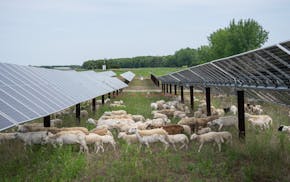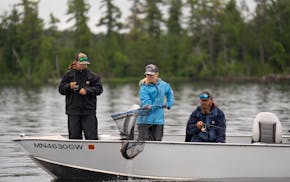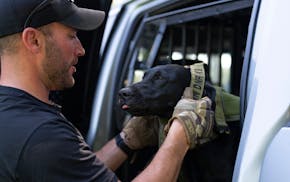At a time when anglers are debating if advanced underwater sonar technology is wrecking the sanctity of fishing, wetting a line on Annie Battle Lake is becoming more of a throwback than ever.
Nestled inside Glendalough State Park in Otter Tail County, this deep and clear 334-acre lake is set aside by the Department of Natural Resources as a haven of old-time fishing. All motors and electronics are banned. During ice fishing season, powered augers also are prohibited.
On Annie Battle, you'll find your fish with the help of a canoe, kayak or rowboat. Is live bait allowed? Yes, but if you're fishing for the lake's prized crappies and bluegills, you can only keep up to five – not the statewide standard limit of 10. Largemouth bass, another protected species in the lake, must be released immediately after catching (and photographing).
"I think a lake like Annie Battle is becoming more of a treasure," said Erik Osberg, an Otter Tail County employee and chairman of the 2021 Governor's Fishing Opener. "You're not driving around, looking at a screen. It's a place where we can all go to experience fishing the way our ancestors did."
Glendalough State Park Director Jeff Wiersma said the so-called heritage fishery was something of an experiment when it opened to the public in 1997 with its non-motorized, non-"aqua view" regulations. It's one of two such lakes in Minnesota, the other is Black Bass Lake at Mille Lacs Kathio State Park, he said.
The Boundary Waters Canoe Area Wilderness is filled with paddle-only lakes and rivers, of course, but there are no regulations there against the use of electronics for fishing.
"It was experimental in the beginning, but Annie has been a huge success story," Wiersma said. "I get lots of people who say there should be more lakes like this."
Encircled by natural shorelines and a 3.2-mile walking path free of private development, the lake attracts serious crappie anglers in May and June and an abundance of families throughout the summer who enjoy wake-free swimming, boating and fishing. Walleyes inhabit Annie Battle, but only in light density. Anglers also target bluegills and northern pike.
Wiersma said the lake never seems crowded, even when Glendalough is at its busiest and when the park's concessionaire is renting lots of watercraft. Anglers often describe their experience as tranquil, he said.
"You can have a lot of boats out there but you can always find a quiet place."
Luke Schalekamp, a DNR Fisheries employee based in Fergus Falls, said one of Annie Battle's charms is as a refuge for anglers turned off by the encroachment of high technology. Especially hot right now is a discussion in fishing circles of forward-facing sonar technology that anglers use to "hunt" muskies in waters where they previously were considered undiscoverable. The advanced imaging allows anglers to roam a lake until they find a fish they want to catch.
Schalekamp said another pristine feature of Annie Battle is its undeveloped shoreline in an area of the state where woodlands give way to prairie.
"I absolutely love it," he said. "There's a sense of peace here … knowing that we're fishing like our grandfathers did."
Annie Battle Lake is about five miles northeast of the town of Battle Lake. Until 1990, it was privately held within a game farm owned by Cowles Media Co. of Minneapolis. At the time, Cowles was the owner of the Star Tribune newspaper and the company donated the historic property to The Nature Conservancy of Minnesota for the purpose of creating Glendalough State Park. (A previous owner gave the name Glendalough to the property in honor of an Irish monastery.)
A Star Tribune story in 1990 noted that Dwight Eisenhower visited the 2,000-acre hunting preserve during his first election campaign.
A survey of the lake taken before it was opened to the public documented populations of walleye, bluegills and crappies "with sizes typically well above average," according to DNR archives.
A fishing frenzy ensued when the state created boat access to the lake. Historical fish surveys indicate an immediate crash in the number of walleyes and crappies. To halt the damage, the DNR closed Annie Battle to fishing for four years while the fish recovered.
During the shutdown, officials devised today's non-motorized regulations and bag-limit restrictions.
"There was interest in maintaining a fishery that was reminiscent of the 'good old days of fishing,' where methods of angling were simple and the quality of fishing was high," then-Area Fisheries Supervisor Arlin Schalekamp wrote in April 2000.
Since Annie Battle Lake reopened in 1997, Wiersma said, the lake's fish populations have been holding their own.

Xcel lets loose a small army of hungry sheep to keep its solar farm in order

Anderson: In early June, Minnesota fish are begging to be caught. Won't you help?

So you want to get an e-bike? Here's what you should know in Minnesota
Baby opossums are emerging from their mothers' pouches

